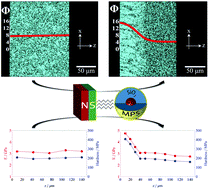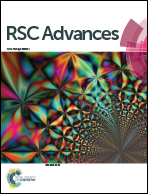A novel synthetic strategy for bioinspired functionally graded nanocomposites employing magnetic field gradients†
Abstract
In order to mimic the complex architecture of many bio-materials and synthesize composites characterized by continuously graded composition and mechanical properties, an innovative synthetic strategy making use of magnetic field gradients and based on the motion of superparamagnetic Fe3O4@SiO2 core–shell nanoparticles is adopted. It is demonstrated that by lowering the viscosity of the system through particle functionalization, and increasing the magnetic force acting on the nanoparticles upon optimization of a simple set-up composed of two permanent magnets in repulsion configuration, the magnephoretic process can be considerably accelerated. Thus, owing to the magnetic responsiveness of the Fe3O4 core and the remarkable mechanical properties of the SiO2 shell, approximately 150 μm thick polymeric films with continuous gradients in composition and characterized by considerable increments in elastic modulus (up to ≈70%) and hardness (up to ≈150%) when going from particle-depleted to particle-enriched regions can be synthesized, even in times as short as 1 hour. The present methods are highly promising for a more efficient magnetic force-based synthesis of inhomogeneous soft materials whose composition is required to be locally tuned to meet the specific mechanical demands arising from non-uniform external loads.


 Please wait while we load your content...
Please wait while we load your content...